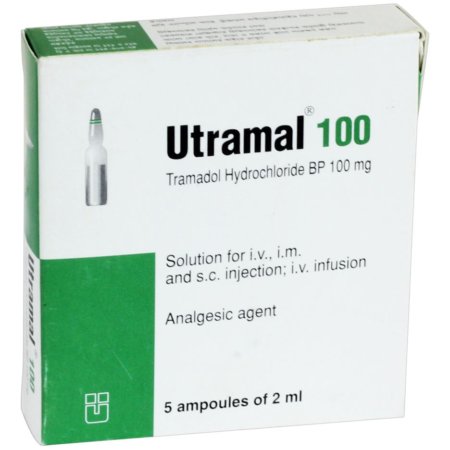
Type:Injection
Generic Name:Tramadol Hydrochloride
Manufacturer:Unimed Unihealth Pharmaceuticals Ltd.
Price:৳25.00
Moderate to severe pain, Postoperative pain
May be taken with or without food.
Oral Moderate to severe pain Adult: Immediate release Chronic pain: 25 mg PO every morning initially; increased by 25-50 mg/day every 3 days up to 50-100 mg PO q4-6hr PRN; not to exceed 400 mg/day Acute pain: 50-100 mg PO q4-6hr PRN; not to exceed 400 mg/day Extended release 100 mg PO once daily initially; increased by 100 mg/day every 5 days; not to exceed 300 mg/day Parenteral Moderate to severe pain Adult: IM/IV: 50-100 mg 4-6 hrly over 2-3 min. Postoperative pain Adult: Initially, 100 mg followed by 50 mg every 10-20 min if necessary, to a total of 250 mg in the 1st hr including initial dose. Thereafter, 50-100 mg 4-6 hrly up to a total daily dose of 600 mg. Elderly: >75 yr Increase dosing interval. Hepatic impairment: Severe: Immediate release, 50 mg PO q12hr; extended release not recommended
Moderate-to-Severe Pain Immediate release <17 years: Safety and efficacy not established >17 years (acute): 50-100 mg PO q4-6hr PRN; not to exceed 400 mg/day >17 years (chronic): 25 mg PO every morning initially; increased by 25-50 mg/day every 3 days as separate doses up to 50-100 mg PO q4-6hr PRN; not to exceed 400 mg/day Extended release <18 years: Safety and efficacy not established
Renal impairment: CrCl (ml/min) Dosage Recommendation 10-30 Increase dosing interval to 12 hrly. <10 Contraindicated.
Suicidal patients, acute alcoholism; head injuries; raised intracranial pressure; severe renal impairment; lactation.
Tramadol inhibits reuptake of norepinephrine, serotonin and enhances serotonin release. It alters perception and response to pain by binding to mu-opiate receptors in the CNS.
Patients who suffer from emotional disturbance or depression, history of epilepsy or risk of seizure, head injury, increased intracranial pressure. Renal and hepatic impairment. Elderly. Pregnancy and lactation. Patient Counselling May impair ability to drive or operate machinery. Monitoring Parameters Monitor pain relief, resp rate, BP, pulse rate; signs of tolerance, abuse, or suicidal ideation. Lactation: Drug excreted at high concentration in breast milk; not recommended
>10% Constipation (24-46%),Nausea (24-40%),Dizziness (10-33%),Vertigo (26-33%),Headache (18-32%),Somnolence (7-25%),Vomiting (9-17%),Agitation (7-14%),Anxiety (7-14%),Emotional lability (7-14%),Euphoria (7-14%),Hallucinations (7-14%),Nervousness (7-14%),Spasticity (7-14%),Dyspepsia (5-13%),Asthenia (6-12%),Pruritus (8-11%) 1-10% Diarrhea (5-10%),Dry mouth (5-10%),Sweating (6-9%),Hypertonia (1-5%),Malaise (1-5%),Menopausal symptoms (1-5%),Rash (1-5%),Urinary frequency (1-5%),Urinary retention (1-5%),Vasodilation (1-5%),Visual disturbance (1-5%) <1% Abnormal gait,Amnesia,Cognitive dysfunction,Depression,Difficulty in concentration,Dysphoria,Dysuria,Fatigue,Hallucinations,Menstrual disorder,Motor system weakness,Orthostatic hypotension,Paresthesia,Seizures,Suicidal tendencies,Syncope,Tachycardia,Tremor Frequency Not Defined Abnormal electrocardiogram (ECG),Angioedema,Bronchospasm,Flushing,Hypertension,Hypotension,Myocardial ischemia,Palpitation,Urticaria,Withdrawal syndrome Potentially Fatal: Respiratory depression.
Increased risk of convulsions or serotonin syndrome w/ SSRI, serotonin-norepinephrine reuptake inhibitors (SNRI), TCA and other seizure threshold lowering drugs (e.g. bupropion, mirtazapine, tetrahydrocannabinol). Decreased serum concentrations w/ carbamazepine. May potentiate the anti-depressant effect of norepinephrine, 5-HT agonists or lithium. Increased INR and ecchymoses w/ coumarin derivatives (e.g. warfarin). Potentially Fatal: Increased risk of seizure and serotonin syndrome w/ MAOIs.